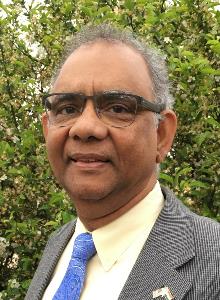June 14, 2016
 Akhlesh Lakhtakia was picking up his daughter from her friend’s house when he noticed a mineral on a table, and it sparked an idea.
Akhlesh Lakhtakia was picking up his daughter from her friend’s house when he noticed a mineral on a table, and it sparked an idea.
“I picked it up and I was immediately floored,” he said.
The mineral was ulexite, a crystal containing fibers that run in one direction. Lakhtakia could see through the crystal only when he looked in the same direction as the fibers.
The next day, Lakhtakia, who at that time was a Pennsylvania State University associate professor of engineering science and mechanics, called his colleague, Russ Messier. Messier had experience in making thin films. Lakhtakia asked if a material could be made in the lab that had a fibrous structure like the crystal. Also, could the film be deposited on a rotating substrate, so that the fibers in the film can be twisted? If so, the film could be an optical filter, allowing only light with the same twisted polarization state to pass through.
Research showed that the films could be made in a lab in a way Lakhtakia and Messier wanted the films to function optically: whether as a filter of light based on polarization, wavelength, or both. Polarization filters, for example, are used on cameras and in sunglasses to reduce the intensity of light entering eyes.
This research resulted in sculptured thin films (STF), a nanotechnology, which has fibers as small as 30–50 nanometers in diameter.
STF applications have expanded into a coating technique called bioreplication. Lakhtakia’s team, for example, used STFs made of nickel to coat the top of a female emerald ash borer to form a mold, then used that mold to create hundreds of decoys so detailed that they trick males better than freshly sacrificed females, disrupting the invasive species’ mating cycle. His research also explored applications for solar energy and forensic science, and he is investigating larger microfibrous films for biomedical uses.
Lakhtakia is the 2016 recipient of Sigma Xi’s 2016 Walston Chubb Award for Innovation, due in large part to his leadership role in developing STFs. He will receive his award, and give a lecture, at Sigma Xi’s Annual Meeting and Student Research Conference in Atlanta this November.
To see a video with Lakhtakia discussing various uses of STFs, visit https://www.sigmaxi.org/programs/prizes-awards/walston-chubb/award-winner/akhlesh-lakhtakia.